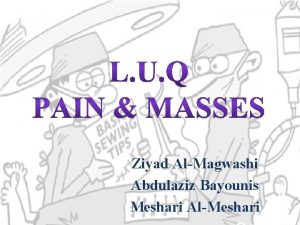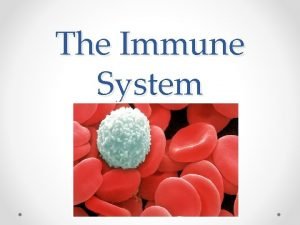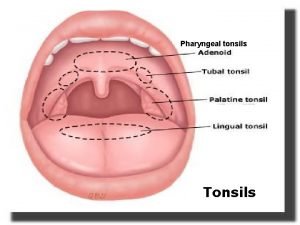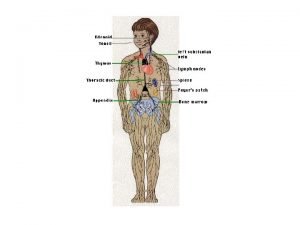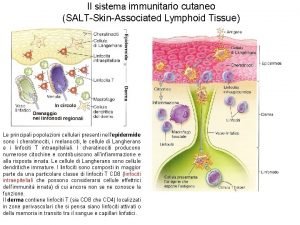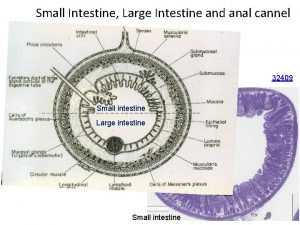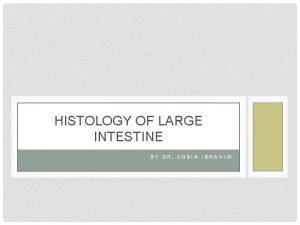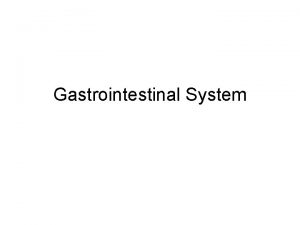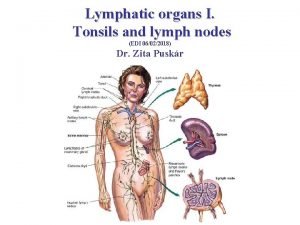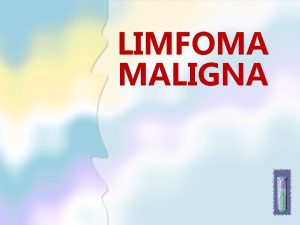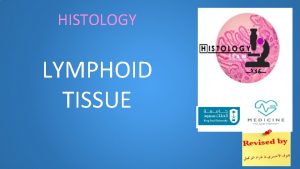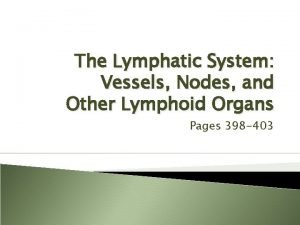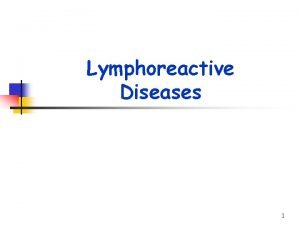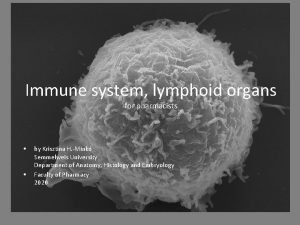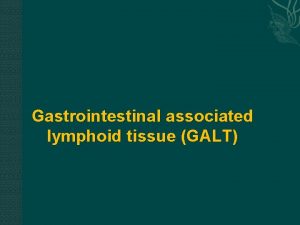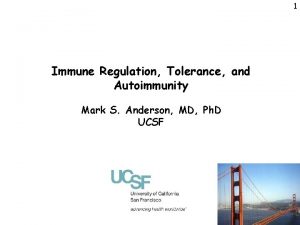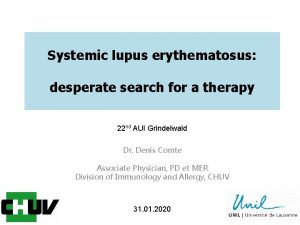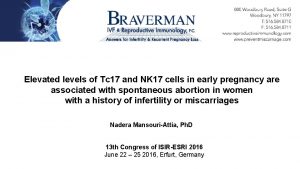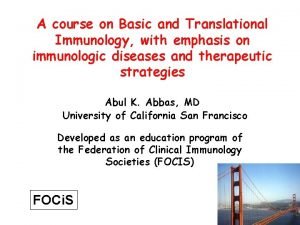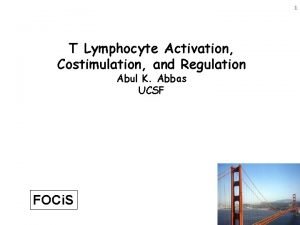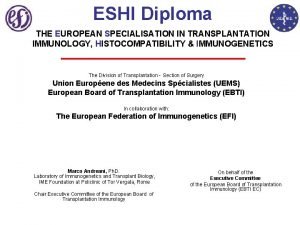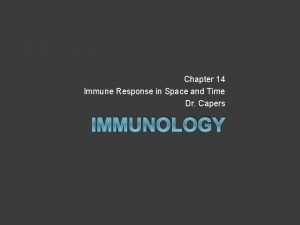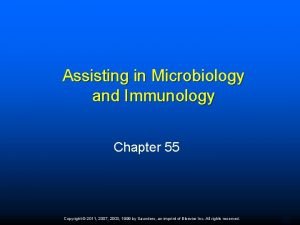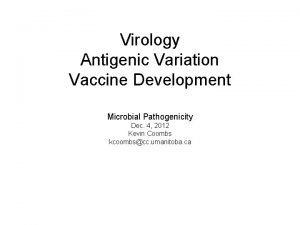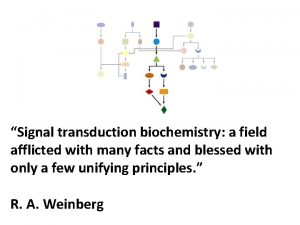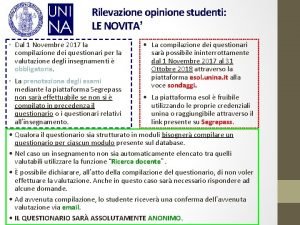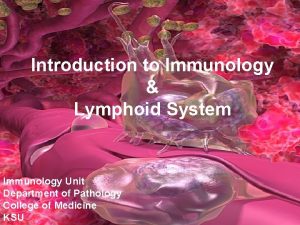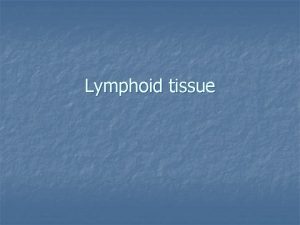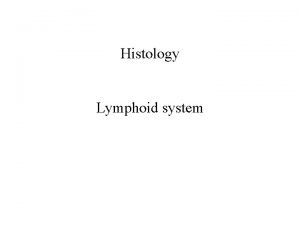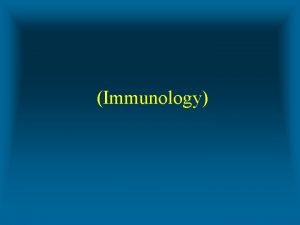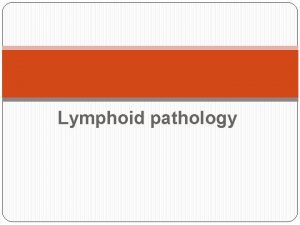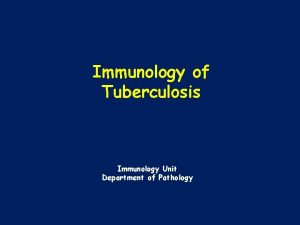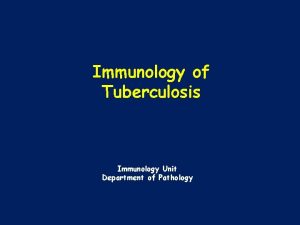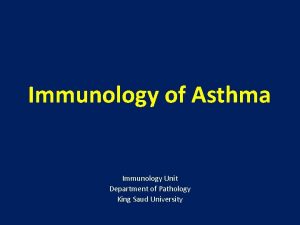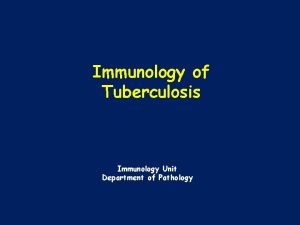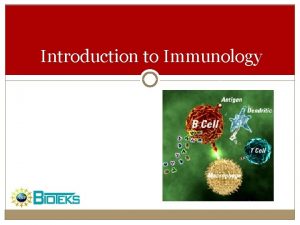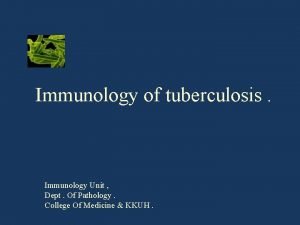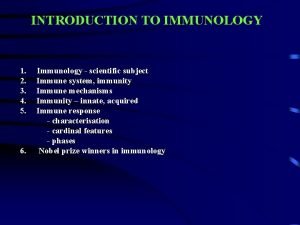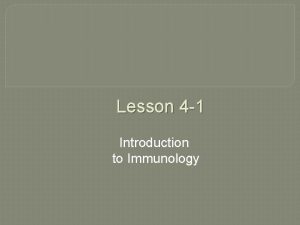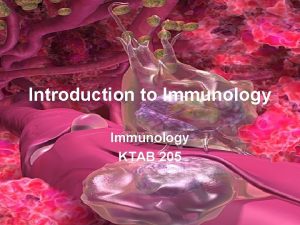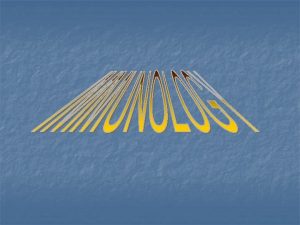Introduction to Immunology Lymphoid System Immunology Unit Department


































- Slides: 34

Introduction to Immunology & Lymphoid System Immunology Unit Department of Pathology College of Medicine KSU

Reference Kuby Immunology 7 th Edition 2013 Chapter 1 Pages 1 -22 & Chapter 2 Pages 27 -57

Objectives • To know the historical perspective of immunology • To be familiar with the basic terminology and definitions of immunology • To recognize immune response cells • To understand types of immune responses • To know about the lymphoid system • To understand T and B cell functions

1798 Edward Jenner Observation: Milkmaids who contracted cowpox (a mild disease) were subsequently immune to small pox

SCARRING BUMPS, BLINDNESS, LIMB DEFORMITIES

1798 Edward Jenner Profound results: (1) Jenner’s technique of inoculating with cowpox to protect against small pox spread quickly throughout Europe. (2) Began the science of Immunology, the study of the body’s response to foreign substances.

Louis Pasteur’s Contributions • Determined through studies of cholera in chickens that the virulence of a pathogen weakens with age (chickens inoculated with old strains not only survive but become resistant) Ø Attenuated – weakened, non-virulent strain whose exposure can confer resistance to disease • Classical experiment Ø Heat attenuated anthrax bacillus and subsequent challenge with virulent Bacillus anthracis in sheep

Louis Pasteur Observation: Cholera

What is immunology? • Immune (Latin- “immunus”) – To be free, exempt – People survived ravages of epidemic diseases when faced with the same disease again – Immunity: The state of protection from infectious disease • The study of mechanisms that humans and other animals use to defend their bodies from invading organisms such as bacteria, viruses, fungi, parasites and toxins

Definitions • (CD) Cluster of Differentiation: molecule with a CD designation has a characteristic cell surface protein are often associated with the cell’s function.

Cellular Markers (CD)

Definitions Antigen (Ag): any substance (usually foreign) that binds specifically to a component of the adaptive immunity. Allergen: noninfectious antigens that induce hypersensitivity reactions, most commonly Ig. Emediated type I reactions.

Definitions • Immunoglobulin (Ig) or Antibodies: - Secreted from plasma cell (B cell) - Consists of a heavy and light polypeptide chains linked to each other via disulfide bonds.

Definitions • Adaptive Immunity: Specific host defenses that are mediated by T & B cells following exposure to Ag. • Innate immunity: Nonspecific host defenses that exist prior to exposure to Ag. • Pathogen: a disease causing organism • Vaccination: deliberate induction of protective immunity to a pathogen

Where & what are antigens? - Microorganisms & their related products (proteins, polysaccharides, lipids) - Environmental substances - Drugs - Organs, tissues, cells



Antigen Presenting Cells Responding Cells CD 3 Positive T Lymphocyte T helper lymphocyte (CD 4) T cytotoxic lymphocyte (CD 8) Th 1 (CD 4) Th 2 (CD 4) Natural Killer Cell B lymphocyte

Types of Immunity • Innate (nonspecific) Immunity – Shorter duration – No memory • Adaptive (specific) Immunity – Response of a specific B and T lymphocytes to an antigen – Exhibit immunological memory – Specificity and – Self / non-self recognition

Adaptive Immunity • Humoral immunity – Immunity that is mediated by antibodies (B cells) • Cell Mediated Immunity – Immune response in which antigen specific T cells dominate

Lymphoid System Lymphatic vessels and lymphoid organs

Primary Lymphoid Organs (Development & Differentiation of immune cells)

Secondary Lymphoid Organs (where the immune response occurs) • Spleen • Lymph nodes • Tonsils • MALT (Mucosa Associated Lymphoid Tissue) • Peyer’s patches • Appendix

Lymphoid series comprise of two main lymphocyte populations T cells and B cells

T-Lymphocyte Differentiation • T cells originate in Bone Marrow then migrate to Thymus for development. • T cell precursors differentiate into mature T cells in thymus • Stem cells lack antigen receptors and CD 3, CD 4, CD 8 surface markers • During their passage through thymus they differentiate into T cells expressing either markers (CD 4 or CD 8)

T-Lymphocytes • All T cells have CD 3 proteins on their cell surface • Mature T cells have either CD 4 or CD 8 proteins but not both

Functions of T Helper Lymphocytes • CD 4 Lymphocytes (T helper 1 and 2: Th 1 and Th 2) • Functions – Help B cells to develop into antibody producing plasma cells (Th 2) – Help CD 8 cells to become activated cytotoxic T cells (Th 1) – Help macrophages in cell mediated immunity (Th 1) during inflammatory response.

CD 8 positive cells Cytotoxic T Cells • About 35% of peripheral blood T cells • Perform cytotoxic functions • They mediate the killing of: Virus-infected cells Tumors Allograft cells (transplant)

B cells • Origin • During embryogenesis – fetal liver • Migrate to bone marrow – final destination • They do not require thymus for maturation

B cells • B cell progenitors like Pro-B cells, Pre-B cells and immature B cells are normally found in bone marrow and Mature B cells are found circulating through body fluids (blood, lymphatic fluid) and lymphoid organs • Mature B cells display surface Ig. M and Ig. D which serves as antigen receptor

The Antibodies

Antibodies are also called Immunoglobulins (Ig) are grouped into 5 classes: Ig. G Ig. M Ig. A Ig. D Ig. E Ig are glycoproteins They differ in size, amount of CHO and biologic functions after binding to specific antigens

Take home message • Normal healthy state is maintained by intact immune response either innate (natural immunity) and/or adaptive (acquired immunity after exposure to antigens) • Cell mediated immunity and humoral immunity is mediated by T and B lymphocytes respectively • Lymphoid system provides suitable environment for development, maturation and proper functioning of cells of immune system

https: //www. youtube. com/watch ? v=VK 7 tr 3 AMia 0
 Cause of splenomegaly in malaria
Cause of splenomegaly in malaria Largest lymphoid organ
Largest lymphoid organ Waldeyer's ring
Waldeyer's ring Lymphoid tissue
Lymphoid tissue Central lymphoid organs
Central lymphoid organs Salt skin associated lymphoid tissue
Salt skin associated lymphoid tissue Largest lymphoid organ
Largest lymphoid organ Generative lymphoid organs
Generative lymphoid organs Anal cannel
Anal cannel Epiplocae
Epiplocae Esophageal varices
Esophageal varices Classify lymphoid organs
Classify lymphoid organs Lymphatic
Lymphatic Tonsils histology
Tonsils histology Lymphoid malignancies
Lymphoid malignancies Lymphoid tissue
Lymphoid tissue Efferent lymphatics
Efferent lymphatics Lymphoid
Lymphoid Juxtacrin
Juxtacrin Malt
Malt Galt secondary lymphoid organ
Galt secondary lymphoid organ Bronchomediastinal trunk
Bronchomediastinal trunk Phagocyte
Phagocyte Antigen antibody
Antigen antibody Central tolerance and peripheral tolerance
Central tolerance and peripheral tolerance Lupus
Lupus Braverman reproductive immunology
Braverman reproductive immunology Cells
Cells Abbas basic immunology
Abbas basic immunology Diploma in immunology
Diploma in immunology Pcams immunology
Pcams immunology Assisting in microbiology and immunology
Assisting in microbiology and immunology Baltimore classification
Baltimore classification Janus kinase
Janus kinase Esol unina
Esol unina
